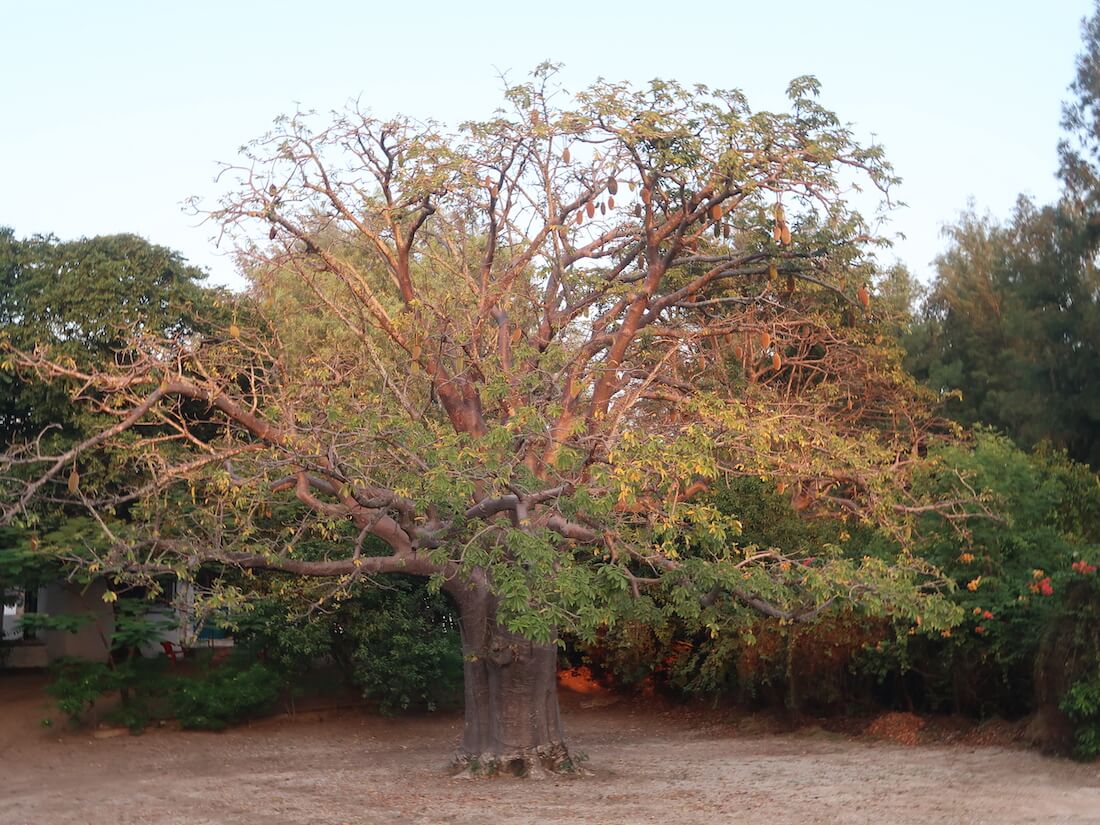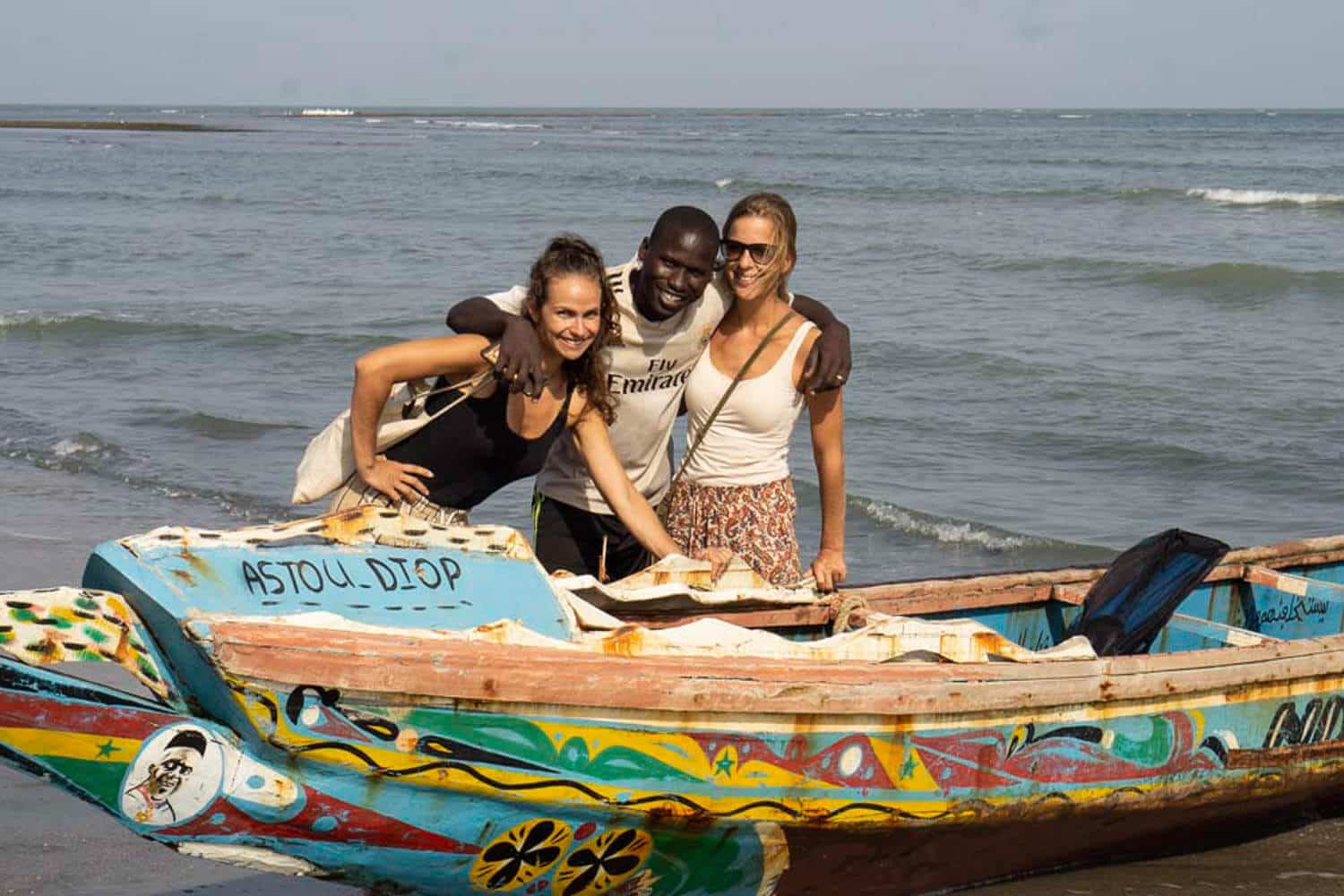Senegal's wild & green South
Duration: at least two weeks
After a quiet adventurous border crossing from Gambia by car, boat, 4×4, and another car we were welcomed to the fascinating universe of Casamance. We immediately liked the captivating region nestled between Ziguinchor and Cap Skirring as it felt very relaxed and authentic.
Take a journey with us and enjoy the scenic beauty of the tiny community campements that dot the banks of the Casamance River. Here, the mangroves and lagoons blend perfectly to create a unique environment.
From sandy beaches to forest-covered islands, there is so much to see and do. Immerse yourself in the beat of traditional villages and soak up the culture of the fiercely independent Diola people, who have made this region their proud homeland.
We loved exploring Abene and Kafountine, two rather traditional villages where the fascinating and fiercely independent Diola people keep their culture alive in the beat of their music and daily life. While we wpuld always enjoy some hours by the beautiful sea, it was a great expereince to hang out in he village and get to know the welcoming locals.

Abene
With its Rastafarian beachy vibes, it was easy for us to fall in love with this place – but it’s important to note that the rastas you’ll meet here are actually Baye Fall, a sect belonging to the Mouride Sufi Brotherhood. And if you’re worried that the tacky Bob Marley tributes that are common in other tourist destinations might be the primary representation of culture here, rest assured that you’ll find plenty of rich Diola culture and genuine hospitality instead. While Abené might be a sleepy village, there are plenty of experiences to be had and things to learn – it’s the perfect place to stop for anyone looking to travel Casamance region and experience life in a truly unique village.

Things to do in Abene
Learn more about the Baye Fall Philosophy
The Baye Fall is a Senegalese Muslim sect that is most easily identifiable by its locked hair, bright patchwork garbs, spiritual amulets, and well-known tenet of hard work. The Baye Fall aren’t all work in no play, though. They are also known for a vibrant art and music scene that combines reggae instrumentation with traditional drumming and singing. It is said that the name “Baye Fall” comes from the Wolof phrase “bayi faddé”, meaning “those who have renounced worldly things”. This name was given to them by other Muslims who were amazed by their commitment to a life of poverty and hard work. The Baye Fall believe that work is a form of worship, and they often work 14-hour days weaving cloth, farming, or collecting firewood. Even children as young as five are expected to contribute to the community. In addition to their hard work, the Baye Fall are also known for their colorful clothes and hairstyles. Women wear brightly-colored dresses with embroidered patterns, while men often sport turbans and amulets. These Amulets are said to protect the wearer from evil spirits. The Baye Fall are a friendly and welcoming community, and they are always happy to share their culture with visitors. If you’re ever in Casamance, be sure to stop by Abene and say hello to the Baye Fall! You might even learn a thing or two about their fascinating way of life.

Visit the Batam Wora
The Batam Wora is a huge tree that has been growing in the town for centuries. The tree is said to be lucky, and many people believe that if you pass through it, you will be blessed with good fortune. The Batam Wora is also an important symbol of peace in the region. Every year, on the last Sunday in January, a festival is held in honor of the tree. During the festival, people from all over Casamance come to pay their respects to the Batam Wora and to celebrate the peace that it represents. The tree is a beautiful sight, and it is definitely worth a visit if you are ever in Abene.

Relax by the beach
We loved hanging out by the beach in Abene. It is very relaxed, never too many people and there are some smaller shacks selling snacks and drinks. There is no dangerous current making it a comfortable beach for swimming.

Kafountine
The bustling town of Kafountine sits only 9 km to the South of Abene. Kafoutnine is a lot livelier with many more restaurants, bars, and shopping choices. Kafountine is a major fishing town in Senegal and while tourism continues to grow, we were told that the 200 canoes installed by the water provide jobs for about 3000-4000 people. While we found the beach in Kafountine to be pretty cute, it is not a beach-vacation town per sé.
Things to do in Kafountine
Kafoutine fish market
The local fish market is truly a sight to behold. As one of the busiest fishing towns in Senegal, you’ll always see some action. We loved getting up early to see the fisherman come back from their nightly trips. There is a lot of running, fish cleaning but also smoking going on. We loved dried fish and found it super interesting to see how it was smoked and prepared.

Take a boat trip
After observing the bustle of the fish market and befriending some of the fishermen, they offered to take us out and show us some of the surrounding islands. While we were a little unprepared for a boat trip (we got great sunburns) we had lots of fun watching the birds and even visiting a cannabis island!
Ziguinchor
Ziguinchor is the capital of the Casmance region and is located right by the Casmance River. We found the city itself to be very unpretentious and certainly not used to catering much to tourists. However, Ziguinchor manages to be relaxed and lively at the same time offering a glimpse into the lives of its diverse population consisting of Diola (Jola), Bainuk, and Fula. Ziguinchor is also reasonably small making it very easy to explore the city on foot. While Ziguinchor is by no means comparable to the Dakar, there is some cool nightlife going on and you can also always find some local exhibitions.

Things to do in Ziguinchor

Casamance River
The Casamnce River gives Ziguinchor a distinct feeling. While several hotels are built by the river, we loved visiting local spots a little bit east of the bridge for our sundowner. During the day, there are plenty of tours around the river to take you fishing or bird watching.
Nightlife in Ziguinchor
Even though Ziguinchor is not a party-mecca, we had lots of fun going out because we could just so easily join the locals and always felt super safe.

Visit Marche Saint-Maurice
This lively market is located South of the river and while we found it to be lively and super interesting, it is still easy to walk and manage even for the more faint-hearted.
Practical travel tips for Senegal
What language is spoken in Senegal?
Several languages are spoken in Senegal, as the country is home to a large number of ethnic groups.
The official language is French, which is used in government, education and the media. Various indigenous languages are also spoken, including Wolof, which serves as a lingua franca and is spoken by a large number of people in everyday life. Other important languages are Fulfulde, Serer, Mandinka and Diola, which are spoken according to regional ethnicity.
What is the best time to travel to Senegal?
Senegal has two seasons, the rainy season and the dry season.
The best time to travel to Senegal is during the dry season, which lasts from October to April. During this time, the temperatures are warm and there is less rainfall.
The Harmattan winds, which blow over from the Sahara desert, also begin to blow at this time. These winds can make conditions hot, dry and dusty. However, they usually subside in April when the temperatures rise again.
Is there Maleria & Dengue Fever in Senegal?
Malaria, dengue fever and other tropical diseases are common, especially during the rainy season (June-September).
Tips for avoiding dengue & malaria
You should take measures to avoid being bitten by mosquitoes. It is best to sleep under a mosquito net and wear long clothes to sleep. Otherwise, you should also keep a low profile at dawn and dusk.
The health facilities in Dakar are adequate, but they are limited in the rest of Senegal.
Make sure you have sufficient travel health insurance and funds to cover the costs of medical treatment abroad and repatriation.
Is Senegal safe?
We always felt very comfortable and safe in Senegal. After dark, however, we were no longer on our own.
What is the currency in Senegal?
Public transportation in Senegal
Internet and SIM cards in Senegal
The connection is quite good in the cities, but network coverage varies greatly in rural areas. There are three telephone providers in Senegal: Orange, Free and Expresso. In general, data packages in Senegal are affordable.
Can I drink the tap water in Senegal?
The water in Senegal is not drinkable, so bring a water filter or a UV bottle.
What should I look out for on my trip?
Sunscreen: Protect marine life by wearing reef-friendly sunscreen.
Waste: Take your water filter with you not only to keep your water cold, but also to avoid plastic waste. A foldable food container and travel cutlery are also a must!
Photography: The people around Lac Rose and Île de Gorée are prone to taking photos, so be extra sensitive.
Packing list Senegal
Don’t know what to pack for your trip to Senegal? You’ll find everything you need on our packing list, from clothing and equipment to eco-friendly toiletries.
Enjoy your trip without worrying about what you’ve forgotten and immerse yourself in the culture of Senegal with the right equipment.
Traveling Senegal?
Discover other African destinationsPlaces to visit Senegal & The Gambia
Day trips from Dakar
Situated on the Atlantic coast, Senegal has beautiful beaches, lagoons, and island archipelagos. Inland, there are forests, savannas, and mountains. When visiting Dakar, there are plenty of things to do and see.
Gambia’s South | Gambia’s best beaches
Gambia’s only 42-km long coastline offers the perfect beach spot for everyone. If you are looking for a party, Kololi is the place to be, but if you seek more tranquility and serenity, check out Gambia’s South.
Serekunda | Gambia’s secret capital
Serekunda is home to about 400.000 people, and it seems to burst at all seams. Serekunda is Gambia’s biggest city and has long become the economic hub. It’s not exactly pretty or relaxing, but it’s worth visiting to get a glimpse into a busy, authentic Gambian city. Serekunda is also home to Gambia’s biggest market. Serekunda offered us an authentic glimpse into urban West African culture and life!




